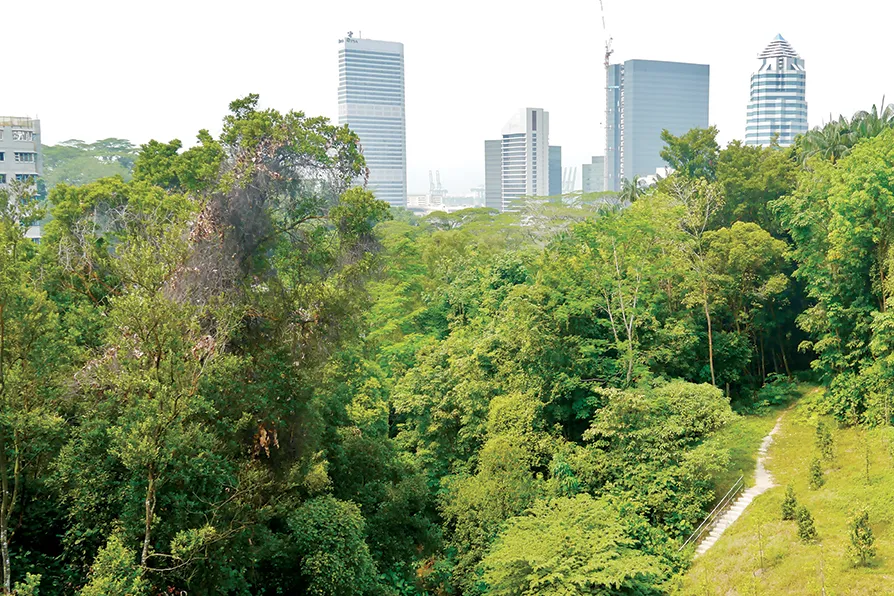Trump’s escalation against Venezuela is about more than oil, it is about regaining control over the ‘natural’ zone of influence of the United States at a moment where its hegemony is slipping, argues VIJAY PRASHAD
Nature's self-reconstruction is both intriguing and beneficial and as such merits human protection, write ROX MIDDLETON, LIAM SHAW and MIRIAM GAUNTLETT

 UNEASY COHABITATION: Southern Ridges, Singapore, 2015. Pic: Zairon/CC
UNEASY COHABITATION: Southern Ridges, Singapore, 2015. Pic: Zairon/CC
SECONDARY forests reclaim land once cleared by humans. Sometimes overlooked by conservationists, their ecology and diversity showcases nature’s resilience
In Robert Zhao Renhui’s artwork The Owl, The Travellers and The Cement Drain, a wild boar trundles along a grassy track by a wire fence, unseen by construction workers. At night, a monitor lizard takes a tentative plunge in a plastic bucket filled with water.
Thermal footage plays of two travellers discovering the ruins of a British military outpost. Sambar deer, thought to be extinct in Singapore, roam, overlooked by distant skyscrapers on the horizon.
Through these and other scenes, the film captures Singapore’s “secondary forests”: those that have grown over land where primary vegetation has been destroyed (either cleared or cultivated) and that have developed a distinct structure and species composition compared to the original forest.
These secondary forests contain both native and foreign species, as well as man-made elements — from colonial ruins to the remnants of migrant workers’ temporary camps.
Singapore is an island off the southern tip of the Malay peninsula. It covers an area of land just over 700 square kilometres, approximately half the size of Greater London. Its history, like the rest of south-east Asia, is one of colonial dispossession.
Colonised by the British in 1819 and established as a key trading-post for the British empire, Singapore was subsequently occupied by Japan during WWII. It became its own sovereign city-state in 1965 after a failed attempt to become part of the Malaysian federation. Today, it is a major hub for maritime shipping, aviation and finance — in other words, a hub for global capital.
Prior to colonisation, Singapore was covered by primeval tropical forest, with mangrove forests lining the coast and inland freshwater swamp forest. By 1900, 90 per cent of this forest had been cleared for timber and to make space for rubber plantations, which made up 40 per cent of Singapore’s land area by 1935.
After Singapore gained independence, the city rapidly urbanised and modernised. By 1990, most of the plantations were abandoned but over 99 per cent of the original tropical forest had been cleared; what was left was confined to two nature reserves.
In 2011, a satellite imaging study found that while vegetation covers 56 per cent of Singapore’s total land area, only 0.28 per cent is primary forest. Of the rest, just over half is spontaneous vegetation, arising without human intervention, while the rest is actively managed (parks, gardens and lawns).
Aside from the very small primary forest area, all of the spontaneous vegetation in Singapore is secondary forest.
The secondary forest can be subdivided into three categories: native-dominated forest, abandoned-land forest, or waste-woodlands. Native-dominated secondary forests are those that regrew on land cleared prior to the 1950s, while waste-woodlands are those that regrew after the 1960s and are dominated instead by exotic tree species rather than native trees.
Abandoned-land forests regrew from land that was previously used for plantations, left with the mature trees largely intact. Land use history therefore has an impact on species composition.
Whether an area has been deforested or used as a plantation will change soil nutrient levels and the soil seed bank. Some of the new exotic species are particularly successful thanks to adaptations uncommon in native species, like wind-dispersal of their seeds.
As seen in Zhao’s film, man-made items and debris also impact life within the secondary forest.
Ecologists sometimes doubt the value of these secondary forests. An article in the journal Biodiversity and Conservation that investigated the diversity of an area of secondary forest in Singapore concluded that “secondary forest cannot be assumed to accrete biodiversity rapidly in the tropics, and may not be of direct value in conservation.
“However, other indirect roles, such as providing resources for native animals, and buffering and protecting primary forest fragments may make the protection of secondary forest worthwhile” (emphasis ours).
Other studies have found that secondary forests do host nationally threatened species, and point out that it is currently unknown whether secondary forests that are currently dominated by exotic species may revert to native dominated forest, given time and assisted natural regeneration.
Secondary forests in Singapore may not have that time. Currently, their unprotected nature means that they are at risk from clearance to make space for developments like residential estates or transport infrastructure.
A study from 2023 found that approximately 2,000 football fields’ worth of secondary forest have been lost in Singapore over the last decade due to urbanisation, leaving fragmented patches of forest, most of which are smaller than one hectare.
More concerning is that there are plans to clear nearly four times more (over half of that existing in Singapore), as stated in the Urban Redevelopment Agency’s 2019 Master Plan for Singapore. The predicted loss of secondary forest is 20 per cent larger than the total area of all the parks and nature reserves in the city.
Even if secondary forest biodiversity is less than primary forest, the clearance of these areas of vegetation will still be a significant loss to national biodiversity. It will also eliminate their beneficial effects on global atmospheric pollution, as well as on the local climate.
Secondary forests help regulate climate through shade and transpiration, filter air by particulate adhesion to leaves and gaseous absorption, and intercept rainfall to reduce stormwater runoff.
Due to its location near the equator, Singapore is already subject to intense heat, humidity and tropical storms; as climate change worsens, extreme weather events will only become more common and the loss of secondary forest will surely hasten this.
Secondary forests exist in a strange dichotomy: they sprung out of the human-controlled destruction of the original landscape of Singapore. Yet now they are unregulated, unlike the two tiny primary forests that are managed as nature reserves. They benefit people, directly and indirectly, but without much recognition.
The vibrant ecosystems captured on camera by Zhao are able to thrive despite not being “valuable” enough to deserve protected status, despite having to grow over and under colonial debris, despite current and future human incursion.
Despite all of it, the clouded monitor and the Sambar deer, the oriental whipsnake and the reticulated python, the collared kingfisher and the crimson sunbird, find ways to survive.













